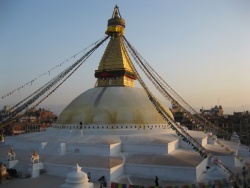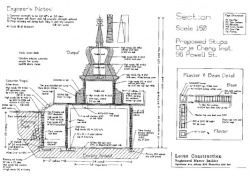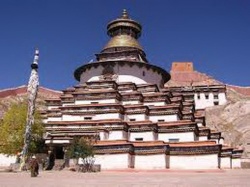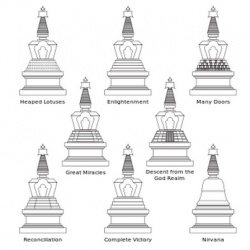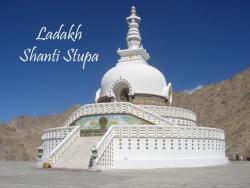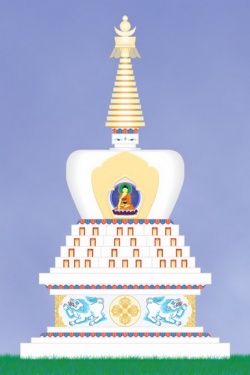Stupa
Click here to see other articles relating to word Stupa
A stupa (from Sanskrit: m., स्तूप, stūpa, Sinhalese: ස්ථූපය, Pāli: थुप "thūpa", literally meaning "heap") is a mound-like structure containing Buddhist relics, typically the ashes of deceased, used by Buddhists as a place of Meditation.
The term "reliquary" is sometimes used, after a Christian functional equivalent.
Stupas are an ancient Form of Mandala.
Description and history
The stupa is the oldest Buddhist religious monument and was originally only a simple mound of mud or clay to cover Relics of the Buddha (cetiya).
After the Parinirvana of The Buddha, his remains were cremated and the ashes divided and buried under eight Stupas with two further Stupas encasing the urn and the embers.
Little is known about these early Stupas, particularly since it has not been possible to identify the original ten monuments.
However, some later Stupas, such as at Sarnath and Sanchi, seem to be embellishments of earlier mounds.
In the third century BC, after his Conversion to Buddhism, the emperor Asoka had the original Stupas opened and the remains distributed among the several thousand Stupas he had built.
Nevertheless, the Stupas at the eight places associated with the life of the Buddha continued to be of particular importance.
Accordingly, the importance of a stupa changed from being a funerary monument to being an object of veneration. As a consequence their appearance changed also.
Stupas were built in Sri Lanka soon after King Devanampiyatissa converted to Buddhism,
the first stupa to be built was the Thuparamaya.
Later on Sri Lanka went on to build many Stupas over the years, some like the Jetavanarama in Anuradhapura being one of the tallest ancient structures in the World.
Sri Lanka also boasts construction of Stupas, which have used most advanced engineering techniques and Knowledge, for example the use of 'lightning conductors' and 'special shelters (vatadage)', which is the reason they have been standing undamaged for thousands of years.
Ghalegay hosts one of the biggest Stupas at Mohallah Singardar in district Swat, Pakistan.
They evolved into large hemispherical mounds with features such as the:
Torana (gateway), the vedica (fence-like enclosure evolved from the vedic villages), the harmika (a square platform with railings on top of the stupa), chattrayashti (the parasol or canopy) and a circumambulatory around the stupa.
Stupa
From the third century BCE onwards, Stupas were incorporated into the hall of the Chaitya-griha.
One such stupa was discovered at Sopara, an ancient port near Mumbai, and is believed to be one of the most ancient Stupas in the World.
The oldest known stupa is the Dhamek Stupa at Sarnath, India, while the tallest is the Phra Pathom Chedi in Nakhon Pathom, Thailand, at a height of 127 metres.
The most elaborate stupa is the 8th century Borobudur monument in Java, Indonesia.
The upper rounded terrace with rows of Bell shaped Stupas contained Buddha images symbolizing Arupadhatu, the sphere of formlessness.
The main stupa itself is empty, symbolizing complete perfection of Enlightenment.
The main stupa is only the crown part of the monument, while the base is pyramidal structure elaborate with galleries adorned with bas relief of scenes derived from Buddhist text depicted the Life of Siddharta Gautama.
Borobudur unique and significant architecture has been acknowledge by UNESCO as the largest buddhist monument in the World.
According to Brahmi, kharoshti, Pali and Sanskrit edicts Ashoka the Great founded 84,000 Stupas all over the south Asia.
The stupa evolved into the Pagoda as Buddhism spread to other Asian countries.
The Pagoda has varied forms that also include bellshaped and pyramidal ones.
Today, in the Western context, there is no clear distinction between the stupa and the Pagoda.
But in general stupa is used for a Buddhist structure of India or south-east Asia, while Pagoda refers to a building in east Asia which can be entered and which may be secular in purpose.
Types of Stupas
Built for a variety of reasons, Buddhist Stupas are classified based on Form and function into five types:
Relic stupa - in which the relics or remains of The Buddha, his disciples and lay saints are interred.
Object stupa - in which the items interred are objects belonged to The Buddha or his disciples such as a begging bowl or robe, or important Buddhist scriptures.
Commemorative Stupas - built to commemorate events in the lives of Buddha or his disciples.
Symbolic stupa- to symbolise aspects of Buddhist theology, for example, Borobuddur is considered to be the Symbol of "the Three Worlds (dhatu) and the Spiritual stages (Bhumi) in a Mahayana Bodhisattva's character."
Votive Stupas - constructed to commemorate visits or to gain Spiritual benefits, usually at the site of prominent Stupas which are regularly visited.
Features of a stupa
Harmika-It is built on the top of the oval shaped stupa.
Medhi-It is an elevated circular Path around the stupa used for Pradhikshina
Toran-It is the Gateway to the stupa.
Vedica-It is a railing meant for the protection of the holy place.
Symbolism
The sharing of the Relics of the Buddha, Zenyōmitsu-Temple Museum, Tokyo
Buddha relics from Kanishka's stupa in Peshawar, Pakistan.
These surviving relics are now housed in Mandalay, Burma.
"The shape of the stupa represents The Buddha, crowned and sitting in Meditation Posture on a Lion Throne.
His crown is the top of the spire; his head is the square at the spire's base; his Body is the vase shape; his legs are the four steps of the lower terrace; and the base is his throne."
Five purified elements
Although not described in any Tibetan text on stupa symbolism, the stupa may represent the five purified elements:
The square base represents Earth
The hemispherical dome/vase represents water
The conical spire represents Fire
The upper lotus parasol and the crescent moon represents air
The sun and the dissolving point represents the element of space
Construction
To build a stupa, transmissions and ceremonies from a Buddhist teacher is necessary.
Which kind of Stupa to be constructed in a certain area is decided together with the teacher assisting in the construction.
Sometimes the type of stupa chosen is directly connected with events that have taken place in the area.
Treasury
All Stupas contain a treasury filled with various objects.
Small Offerings called Tsa-Tsas fill a major part of the treasury. Creation of various types of Tsa-Tsas is a ceremony itself.
Mantras written on paper are rolled into thin rolls, and put into these small clay Stupas.
Filling the treasury, one layer of Tsa-Tsas are placed, and the empty space between is filled with dry sand.
On the new surface appearing, another layer is made, until the entire space of a treasury is full.
The number of Tsa-Tsas are dependent on the size of both the treasury and Tsa-Tsa, since it should be completely filled.
For example, the Kalachakra stupa in southern Spain has approximately 14 000 Tsa-Tsas within.
Jewellery and other "precious" objects are also placed in the treasury.
It is not necessary that the jewellery be expensive, since it is the symbolic value that is important, not the market price.
It is believed that the more objects placed into the stupa, the stronger the energy of the Stupa will be.
Tree of Life
A very important element in every Stupa is the Tree of Life.
It is a wooden pole covered with Gems and thousands of Mantras, and placed in the central channel of the stupa.
It is placed here during a ceremony or initiation, where the participants hold colorful ribbons connected to the Tree of Life.
Together the participants make their most positive and powerful wishes, which are stored in the Tree of Life. In this way the stupa is charged up, and will start to function.
Benefits
Building a stupa is considered extremely beneficial, leaving very positive karmic imprints in the mind.
Future benefits from this action will result in fortunate rebirths.
Fortunate worldly benefits will be the result, such as being born into a rich family, having a beautiful Body, a nice voice, and being attractive and bringing Joy to others and having a long and happy Life, in which one's wishes are fulfilled quickly.
On the absolute level, one will also be able to reach Enlightenment, the goal of Buddhism, quickly.[7]
Destroying a stupa on the other hand, is considered an extremely negative deed, similar to killing.
Such an action is explained to create massive negative karmic imprints, leading to massive future problems.
It is said this action will leave the mind in a state of paranoia after Death has occurred, leading to totally unfortunate rebirths.
Eight great Stupas
There are eight different kinds of Stupas in Tibetan Buddhism, each referring to major events in The Buddha's Life.[5]
lotus Blossom Stupa
Also known as Stupa of Heaped Lotuses or Birth of the Sugata Stupa, this stupa refers to The Birth of the Buddha.
"At birth Buddha took seven steps in each of the four directions":
In each direction lotuses sprang, symbolizing the Four Immeasurables:
Love,
COMPASSION,
Joy and
Equanimity.
The four steps of the basis of this stupa is circular, and it is decorated with lotus-petal designs.
Occasionally, seven heaped lotus steps are constructed.
These refer to the seven first steps of The Buddha.
Enlightenment Stupa
Also known as the Stupa of the Conquest of Mara.
This stupa symbolizes the 35-year-old Buddha's attainment of Enlightenment under the Bodhi tree in Bodh Gaya, where he conquered worldly temptations and attacks manifesting in the Form of Mara.
Stupa of Many Doors
Also known as the Stupa of Many Gates.
After reaching Enlightenment, The Buddha taught his first students in a deer-park near Sarnath.
The series of doors on each side of the steps represent the first teachings: The Four Noble Truths, the Six Perfections, the Noble Eightfold Path and the Twelve Links in the Chain of Dependent origination.
Stupa of Descent from the God Realm
At 42 years of age, Buddha spent a summer Retreat in Tushita Heaven, where his mother had taken Rebirth.
In order to repay her Kindness he taught the Dharma to her Reincarnation.
Local inhabitants built a stupa like this in Sankasya in order to commemorate this event.
This stupa is characterized by having a central projection at each side containing a triple ladder or steps.
Stupa of Great Miracles
Also known as Stupa of Conquest of the Tirthikas.
This stupa refers to various Miracles performed by The Buddha when he was 50 years old.
Legend claims that he overpowered maras and heretics by engaging them in Intellectual arguments and also by performing Miracles.
This stupa was raised by the Lichavi kingdom to commemorate the event.
Stupa of Reconciliation
This stupa commemorates The Buddha's resolution of a dispute among The Sangha.
A stupa in this design was built in the kingdom of Magadha, where the reconciliation occurred.
It has four octagonal steps with equal sides.
Stupa of Complete Victory
This stupa commemorates Buddha's successful prolonging of his Life by three months. It has only three steps, which are circular and unadorned.
Stupa of Nirvana
This stupa refers to the Death of The Buddha, when he was 80 years old.
It symbolizes The Buddha's complete absorption into the highest state of mind. It is Bell-shaped and usually not ornamented.
A 9th kind of stupa exists; the Kalachakra stupa.
Its symbolism is not connected to events in The Buddha's Life, but instead to the symbolism of the Kalachakra Tantra, created to protect against negative energies.
Regional names
Regional names for stupa include:
Chaitya (Nepal)
Dāgaba (usually spelled "Dagoba") (Sinhalese: දාගැබ, from Sanskrit Dhātu-garbha. (दातु-गर्भ) "relic-chamber" )
Chedi (Thai: เจดีย์, from the Pāli cetiya (चेतिय)
Candi (Indonesia and Malaysia, pronounced 'chandi').
Chorten (Tibet, Ladakh (India) and Bhutan) མཆོད་རྟེན༏ (Wylie: mchod rten), "basis of Offering")[3]
Chedey (Cambodia)[3]
Phrathāt (Lanna)
Havitta (Dhivehi: ހަވިއްތަ) or ustubu (Maldives)
Suburgan/Suvarga (Mongolia)
Субурган (Russia)
Tap (Korea 塔/탑, from Chinese)
Tháp (Vietnam 塔, from Chinese])
Thart (Laos)
Ta (Chinese: 塔; Mandarin Pinyin: tă; Jyutping: taap3), ancient transliteration of Sanskrit stupa.
Sotoba (Japan 卒塔婆/そとば, Tō (Japan 塔/とう, from Chinese)
Zedi (Myanmar [[Zedi] စေတီ) /Pahto (ပုထိုး])
Setaow (စေတဳ, /cetɔe/)
Tseti (ၸေႇတီႇ) or Puhto (ပူႉထူဝ်း)
Chedi/Thoopam (Tamil
Pagoda South East Asia[3]
Tope (Hindi: स्तूप, from the Sanskrit)
Garbha (Sanskrit: गर्भ, meaning a storehouse or repository)
The Eight Stupas
The eight stupas
Footnotes
